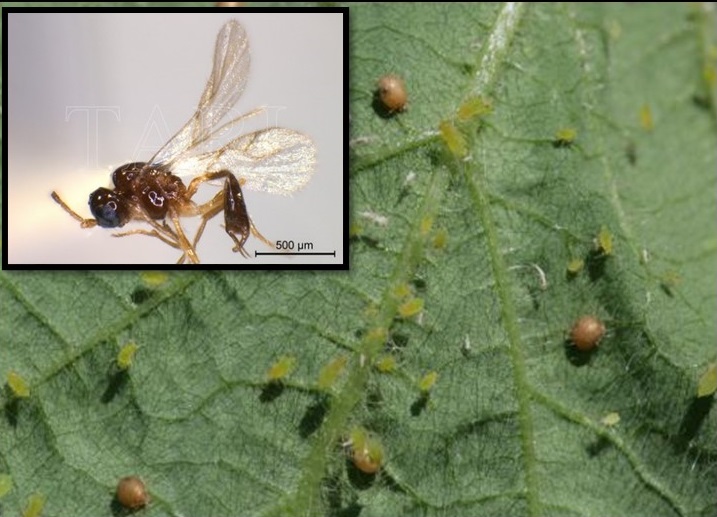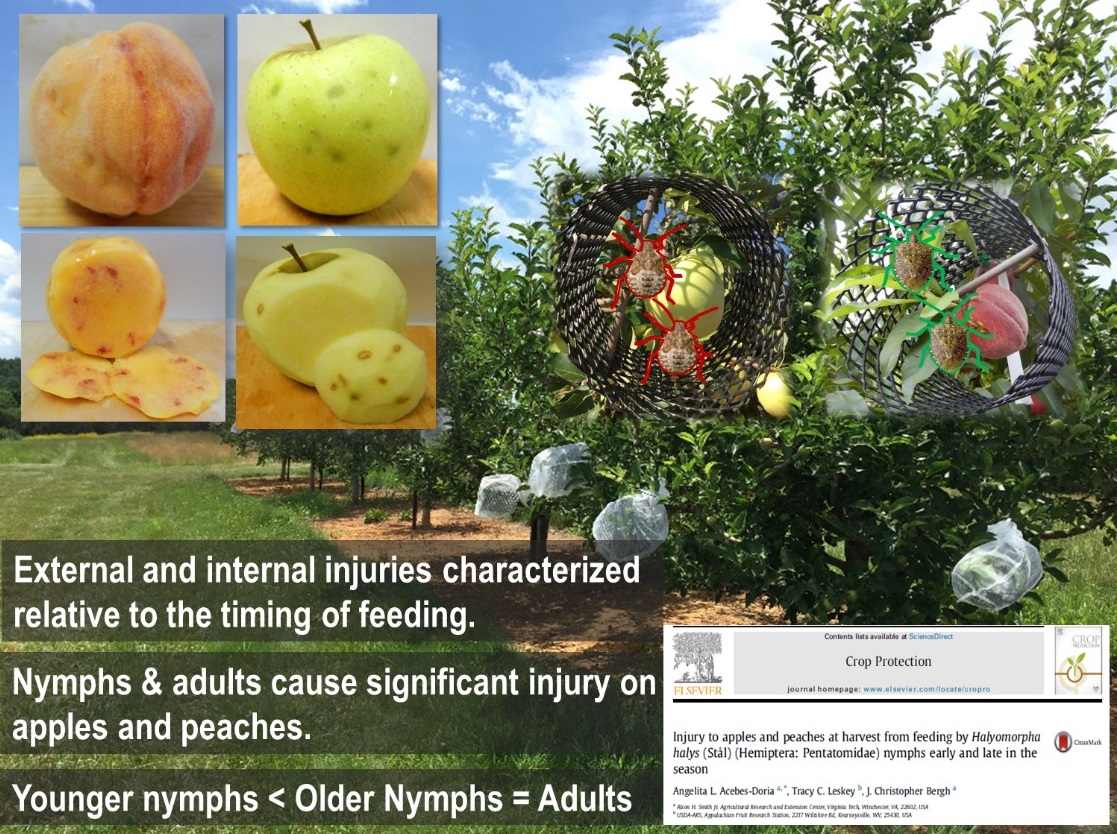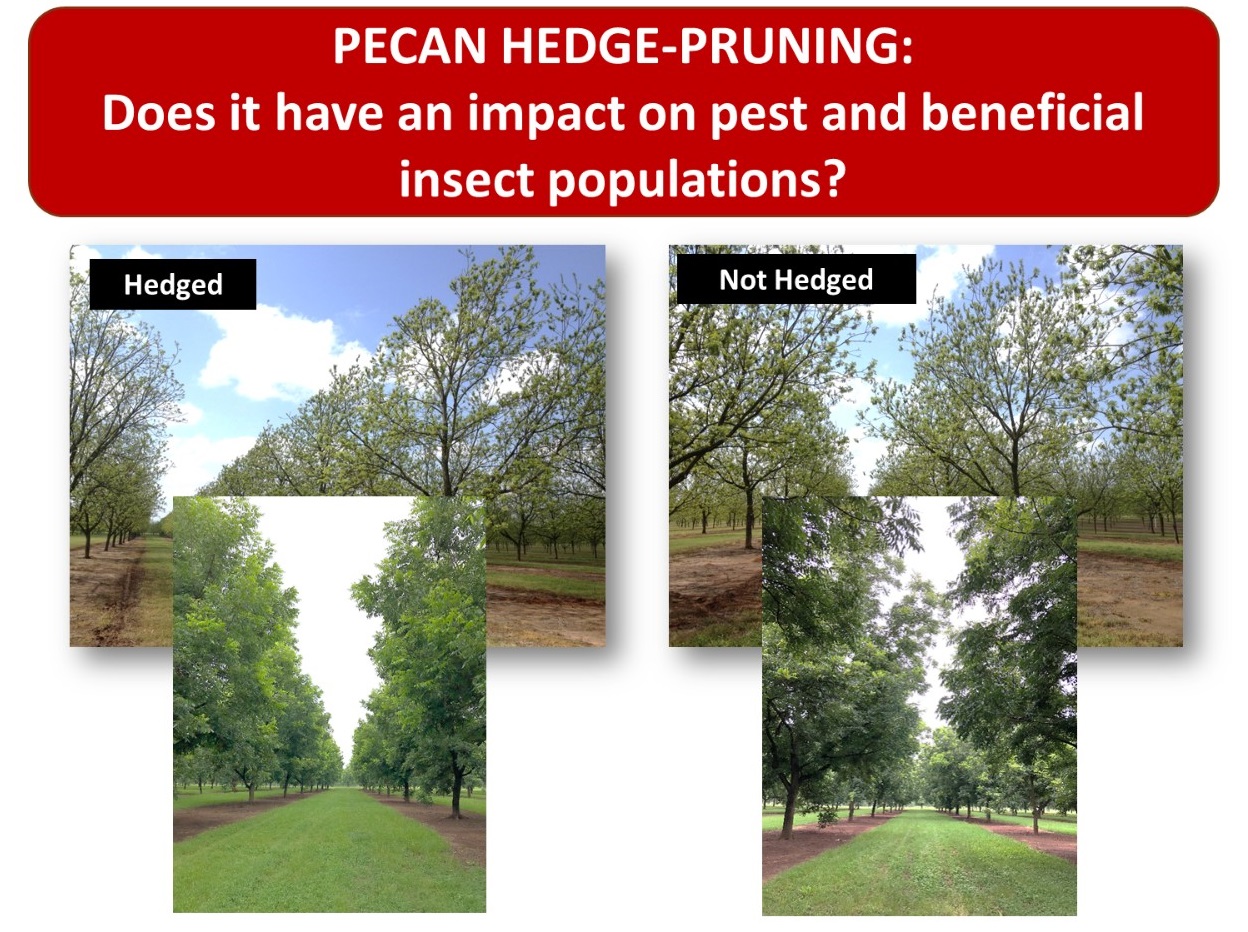| Angelita Acebes-Doria |

|
|
Contact Information USDA-ARS Daniel K. Inouye U.S. Pacific Basin Agricultural Research Center |
|
Publications
via ARIS system
via Google Scholar
via Research Gate
Education
Ph.D. in Entomology. 2016. Virginia Polytechnic and State University
M.S. in Entomology. 2011. University of Hawaii – Manoa
B.S. in Agriculture. 2007. University of the Philippines, Los Baños
Academic Positions
Research Biologist, USDA-ARS, PBARC, Hilo, Hawaii, 2021-Present
Assistant Professor, University of Georgia – Tifton, Tifton, Georgia, 2018-2021
Postdoctoral Researcher, USDA-ARS Appalachian Fruit Research Station, Kearneysville, WV, 2017-2018
Postdoctoral Researcher, Virginia Tech, Alson H. Smith Agricultural Research and Extension Center, Winchester, VA, 2016-2017
Research Emphasis
Integration of biological and ecological information on the development of effective, ecologically based, and environmentally sound management strategies against agricultural pests. Current research focus is on tree nut integrated pest management with priorities on developing effective monitoring and management strategies for tree nut arthropod pests and finding long-term sustainable means of pest population regulation (e.g., biocontrol, cultural) in perennial tree nut systems.
Research Accomplishments
Classical Biological Control of Aphids in Hawaii.
 Invasive species often invades a new area without the natural enemies that help regulate their population. Classical biological control involves the introduction of a natural enemy from the pest’s native range to reunite the pest and its natural enemy, but success often rests on understanding the biology and ecology of the parasitoid. As part of my MS research, I introduced a parasitoid, Binodoxys communis into Hawaii for classical biological control of invasive aphids and conducted host range testing with the imported wasp. I also assessed the attack preferences of a hyperparasitoid between an extant parasitoid species and the newly introduced parasitoid.
Invasive species often invades a new area without the natural enemies that help regulate their population. Classical biological control involves the introduction of a natural enemy from the pest’s native range to reunite the pest and its natural enemy, but success often rests on understanding the biology and ecology of the parasitoid. As part of my MS research, I introduced a parasitoid, Binodoxys communis into Hawaii for classical biological control of invasive aphids and conducted host range testing with the imported wasp. I also assessed the attack preferences of a hyperparasitoid between an extant parasitoid species and the newly introduced parasitoid.
My research demonstrated that B. communis only attacks aphids and as there are no native aphid species in Hawaii, non-target effects should be minimal. This biological control agent was subsequently released in Hawaii to help control the melon aphids, Aphelinus gosspypii, partially as a result of this research. I conducted field releases of B. communis which showed short-term parasitoid establishment in the field. This provided a sustainable option for the IPM programs on melon aphids in vegetable and taro production in Hawaii. My subsequent work on aphid hyperparasitism in the field is one of the first studies to examine the potential impacts of hyperparasitoids on a classical biocontrol program, helping inform subsequent and future biocontrol research programs to consider hyperparasitism as a factor for natural enemy establishment.
Improved Management of Brown Marmorated Stink Bug (BMSB) by determining its dispersal ecology.
 I characterized injury caused by nymphal and adult feeding of BMSB on apples and peaches at different points during fruit maturity and determined the suitability of wild and tree fruit hosts for development and survivorship, showing the importance of mixed host diets on BMSB development and survival. I also developed a novel BMSB trap to study the upward and downward movement of nymphs on host trees and was the first to explore nymphal movement at the orchard-woodland interface throughout the season and evaluated pheromone lure-based monitoring.
I characterized injury caused by nymphal and adult feeding of BMSB on apples and peaches at different points during fruit maturity and determined the suitability of wild and tree fruit hosts for development and survivorship, showing the importance of mixed host diets on BMSB development and survival. I also developed a novel BMSB trap to study the upward and downward movement of nymphs on host trees and was the first to explore nymphal movement at the orchard-woodland interface throughout the season and evaluated pheromone lure-based monitoring.
BMSB is highly polyphagous with >170 host plants, and one of the most damaging pests in the mid-Atlantic region, particularly in orchard crops. In 2010, Mid-Atlantic apple growers incurred $37 million in losses, while stone fruit growers reported crop losses of >50%. My research on characterizing BMSB injuries on apples and peaches was useful for improving the ability of growers to accurately assess crop loss. My PhD research on the effects of host plants on BMSB development and fitness and season-long movement improved the understanding of BMSB population dynamics and helped with developing spatially and temporally precise pest management strategies. My research on the refinement of a trap-based monitoring for BMSB enabled research on phenology modeling and provided a practical tool for BMSB monitoring and bio-surveillance efforts in BMSB-invaded areas across the United States.


Developed a comprehensive IPM program for pecans.

Pecans grown in the southeastern U.S. suffer from a variety of serious insect pests, including ambrosia beetles, aphids, mites, and weevils. I led a pioneering work on the phenology of ambrosia beetles in pecans, refined ambrosia beetle monitoring techniques, and evaluated various management tactics, particularly for newly planted orchards. Pecan aphid-parasitoid interactions were also studied in commercial pecan orchards in Georgia, focusing on the effects of insecticides on population dynamics. My team explored the impacts of pecan hedge-pruning on IPM, which, thus far, suggests no detrimental effects. Innovative tactics for pest control are also under development, including the use of insecticidal netting against pecan weevils and the use of drones to release predatory mites above the pecan canopy for leaf scorch mite control.
 Our work has been instrumental in providing pecan growers information on scouting procedures for ambrosia beetles, particularly in the spring when young trees are most vulnerable. We also established web-based monitoring systems for ambrosia beetles in the eastern US and pecan nut casebearer in Georgia accessible by growers and researchers. Our work led to the development of official grower recommendations for the management of pecan pests, including ambrosia beetles and pecan aphids, made available through extension publications and the MyIPM App. Pecan aphid management now emphasizes rotation of aphicidal materials with multiple modes of action that are not harmful to the pecan aphid parasitoid, Aphelinus perpallidus, and reduces the development of resistance. The pecan hedge-pruning project led to a multi-disciplinary Southern Sustainable Agriculture Research and Education project, which has engaged entomologists, horticulturist, plant pathologist and economist from the Univ. of Georgia and USDA, to study the ecological and economic feasibility of pecan hedge-pruning in the southeastern US.
Our work has been instrumental in providing pecan growers information on scouting procedures for ambrosia beetles, particularly in the spring when young trees are most vulnerable. We also established web-based monitoring systems for ambrosia beetles in the eastern US and pecan nut casebearer in Georgia accessible by growers and researchers. Our work led to the development of official grower recommendations for the management of pecan pests, including ambrosia beetles and pecan aphids, made available through extension publications and the MyIPM App. Pecan aphid management now emphasizes rotation of aphicidal materials with multiple modes of action that are not harmful to the pecan aphid parasitoid, Aphelinus perpallidus, and reduces the development of resistance. The pecan hedge-pruning project led to a multi-disciplinary Southern Sustainable Agriculture Research and Education project, which has engaged entomologists, horticulturist, plant pathologist and economist from the Univ. of Georgia and USDA, to study the ecological and economic feasibility of pecan hedge-pruning in the southeastern US.


Service, Leadership and Participation in Professional Activities:
Membership in Professional Societies and Working Groups
- Entomological Society of America, Member (2008 – present)
- Biological Control Multi-State Working Group, Member (2019 – 2021)
- Pecan Entomology Multi-State Working Group, Member (2018 – 2021)
- Georgia Entomological Society, Member (2018 – 2021)
- Brown Marmorated Stink Bug Working Group, Member (2014 – 2021)
Professional Service Overview
- Subject Editor: ESA Environmental Entomology Journal (2019 – present)
- President: Pecan Entomology Multi-State Working Group (2020 – 2021)
- Lead Organizer: Ambrosia Beetle Working Group (2019 – 2021)
- Journal Peer Reviewer
- Grant Panel Reviewer
- Extension Publication Reviewer
Honors, Awards, Achievements and Recognition:
Selected Recent Grants
- 2021 USDA-SCRI. Ecology and Integrated Management of Ambrosia Beetles in Eastern US Orchard and Ornamental Tree Crops (PD for pre-proposal, co-PI for final proposal) $7.5 M
- 2021 Georgia Pecan Commodity Commission. Insect Management of Pecan. (PD) $29,000
- 2020 USDA-SCRI. Flatheaded Borer Management in Specialty Tree Crops (co-PI) $ 6M
- 2020 Southern SARE. Pecan Hedge-pruning: A Sustainable Management Option for the Southeastern US (PD) $300,000
- Southern IPM Center. IPM Working Group to Address Ambrosia Beetle Issues in Tree Fruit, Tree Nut and Nurseries in the Eastern and Southern US (PD) $25,000

